EPSC-Shell Canada Sedimentology Field Trip 2016: Neogene Basins of Southeastern Spain
As part of EPSC 425 (Sediments to Sequences) and a coupled graduate course on sedimentary basins, 14 undergraduate students, 3 graduate students, and I traveled to southern Spain in late February and March to visit the Neogene sedimentary basins of Almería Province, Andalucia. This was the second Spain field trip run as part of EPSC 425 and with the support of Shell Canada, and it was every bit as great as the first trip—minus the hiccup of a significant snowstorm our first few days, when we tried to visit a new area.
Days 1–3. The 17 McGill students and I met at Madrid Barajas airport on Friday, February 26. After a few challenges tracking everybody down and renting appropriately sized vans, we set off for Aliaga, a village about half way between Madrid and Barcelona. This was new area for this trip, and the goal was to study the Aptian Maestrat basin and visit several locations near a carbonate platform-basin transition. Previous work in this region had revealed spectuarly preserved systems tracts and associated sequence stratigraphic surfaces, the likes of which are often difficult to idenitify on carbonate platforms. Unfortunately, although the region was beautiful and looked as promising for a field trip as the papers and guidebooks suggested, this attempt to branch out into older basins in Spain failed when much of the Iberian Peninsula was pounded by an uncharacteristic late winter storm. The 35 cm of wet snow not only precluded any possibility of visiting outcrops, but also added a challenge to our escape to the south of Spain. Fortunately, we managed to plough through several snow drifts and our hearty students pushed the vans up a few snow-encrusted hills as we made our way back to the main highway. After a long day's drive south, which took us through the endless orange orchards around Valencia and across many mountains of Cretacious carbonate and Betic schists, we found an empty hotel near our first field trip stop in the south. All were ready to peal out of the vans and find dinner.
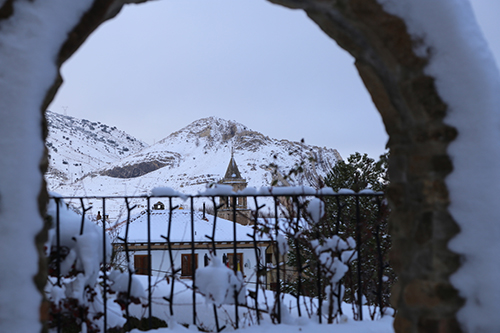 The view from our hotel during an early break in the heavy snowfall. A hint of some really interesting geology shows beneath the snow.
The view from our hotel during an early break in the heavy snowfall. A hint of some really interesting geology shows beneath the snow.
Day 4. After an early start, we spent the day in the Sorbas basin, one of several small and geographically distinct sedimentary basins that flanks the basement uplifts in the region. Following an overview of this and the other basins in the area, we spent much of the rest of the day puzzling over spectacular gypsum deposits and associated marl-carbonate cycles deposited during the Messinian. By the time the sun approached the horizon, the students had formulated hypotheses for how orbitally controlled glacial-interglacial cycles could account for the transitions between seafloor (selenite) gypsusm, gypsum supercones (visible in the photo below), and marl. It was time to return to our beachside apartments in Carboneras.
 Making sense of the evaporite-marl cycles.
Making sense of the evaporite-marl cycles.
Day 5. Having found our bearings in the Sorbas basin the day before, we spent the next day studying spectacular marine to margin-marine sequences of the late Messinian Sorbas Member exposed around the precipitous village of Sorbas. Here, the students could see prograding and shoreface systems (again related to glacioeustasy) and the attendant change in facies. Perhaps most spectacularly, barrier island and lagoon deposits are preserved in three dimensions just behind the village and below the transition from a restricted marine basin to a purely terrestrial basin. After establishing the sequence stratigraphic framework of these strata and describing rare, siliciclastic-dominated stromatolites, the students had the opportunity to explore the Sorbas caves—carved out of the evaporites that occur stratigraphically below the Sorbas Member.
 The view behind (to the northeast of) the village of Sorbas. The cliffs below are made up of foreshore sandstone, and the recessive beds above are lagoonal mudstone. The upward continuity of sandstone on the right side of the photo (basinward) reveals the location of the ancient barrier island, and the tongue of sand in the middle of the photo shows spill-over of those sands in a flood-tidal delta.
The view behind (to the northeast of) the village of Sorbas. The cliffs below are made up of foreshore sandstone, and the recessive beds above are lagoonal mudstone. The upward continuity of sandstone on the right side of the photo (basinward) reveals the location of the ancient barrier island, and the tongue of sand in the middle of the photo shows spill-over of those sands in a flood-tidal delta.
Day 6. Having finished our work in the Sorbas basin, we continued the next day to the Tabernas basin, which although tenuously linked to and coeval with the Sorbas basin, is filled by very different strata. We began the morning walking through a transition from coarse alluvial fan deposits into fan-delta deposits, which provided a perspective on the source of sediments that rapidly filled this basin. We spent the rest of the day in the axis of the basin, where we investigated turbidites and gravity flow deposits, some of which filled deep subaqueous canyons and tectonically confined sub-basins. We also found the Gordo Megabreccia, a thick and jumbled unit indicating massive failure of the slope, presumably related to Neogene seismity in the basin.
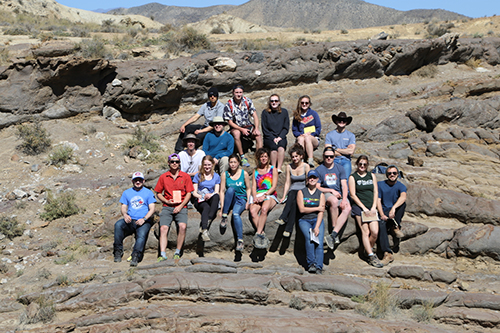 The group sitting on turbidites and debris flow deposits filling a deep, subaqueous channel carved into marls in the axis of the Tabernas basin. Click here for a high- resolution version of this photo.
The group sitting on turbidites and debris flow deposits filling a deep, subaqueous channel carved into marls in the axis of the Tabernas basin. Click here for a high- resolution version of this photo.
Day 7. Spending the night in Tabernas gave us the opportunity for a full day as we made our way towards Guadix. We started near the small town of Alboduloy, which sits on the northwestern margin of the Tabernas basin. This is where we had met Spanish sedimentologist Fernando García-García on the previous field trip and were first introduced to extraordinary, cyclic gilbert delta deposits, exposed in all their glory in the walls of a small river. This spot is quite simply a sequence stratigraphy laboratory, and we spent a few hours sketching the bottomset, clinform, and bottomset beds of multiple cycles and understanding how the interplay between eustatic sea level fluctuations and subsidence influence the distribution of coarse- and fine-grained sediments within the delta complex. In places, cobbles deposited in distributary bars in the topset beds are imbricated shoreward (up the slope of the accretionary cross beds), indicating reworking by waves. On other spots, the bars are capped by small coral reefs, which form during the transgressions.
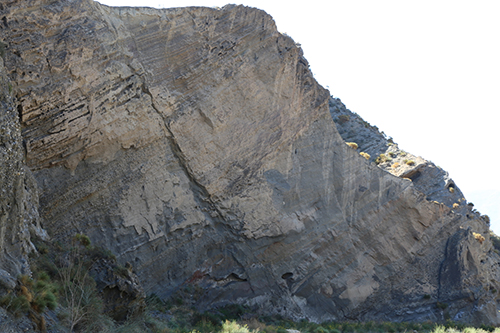 Unfortunately, the canyon walls are in shadow in the morning and not easy to photograph. Nevertheless, the clinforms of two cycles are readily visible in the center and bottom right of the photo, and a thick set of coarse-grained topset beds can be seen in the upper left of the photo.
Unfortunately, the canyon walls are in shadow in the morning and not easy to photograph. Nevertheless, the clinforms of two cycles are readily visible in the center and bottom right of the photo, and a thick set of coarse-grained topset beds can be seen in the upper left of the photo.
After lunch, we continued to the La Peza reservoir on the southern margin of the Guadix basin, where the cyclicity is expressed in marl to sandy carbonate rhythms. These cycles, dipping northward, had previously been misinterpreted to be clinform deposits, but García-García recognized that they represent instead a tide- and storm-dominated mixed clastic-carbonate ramp system that was subsequently tilted by uplift in the Sierra Nevada. Unfortunately, construction near the base of La Peza dam prevented us from seeing the impressive overturned cross-beds there, but we did find cool ripples migrating up the lee-side of large subaqueous dunes. Later that evening, a group of us retraced our steps to the Bodega Calatravas, a great tapas place we had found on the previous trip.
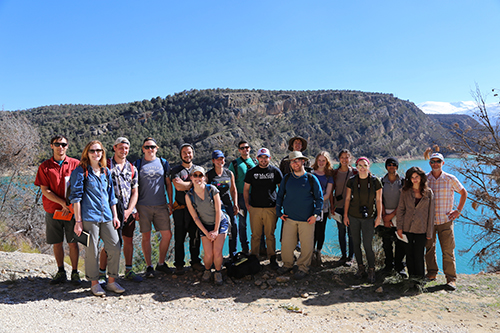 The group at La Peza Reservoir, on the north side of the Sierra Nevada (visible in the background on the right) on the penultimate day of the trip. The Miocene-aged, dipping beds in the background were previously interpreted as clinoform deposits, but are more likely cyclic ramp deposits. Click here for a high-resolution version of this photo.
The group at La Peza Reservoir, on the north side of the Sierra Nevada (visible in the background on the right) on the penultimate day of the trip. The Miocene-aged, dipping beds in the background were previously interpreted as clinoform deposits, but are more likely cyclic ramp deposits. Click here for a high-resolution version of this photo.
Day 8. This was our last day in the field. We spent the morning looking at the Gilbert fan delta system where coarse-grained sediments were deposited in the bottomsets and foresets and clinoforms shrunk as base level dropped and the basin filled up. In the exposures near Dehesas de Guadix, the students could see explicity a falling stage systems tract (FSST) and an associated incised alley. By the time we wrapped up the visit to this spot, the warm and clear weather we had enjoyed in the south of Spain to date gave way to another cold system. It was time to hit the road for Toledo, where we sould spend our last night together as a group before continuing on to Madrid and finding our way back to Montreal.
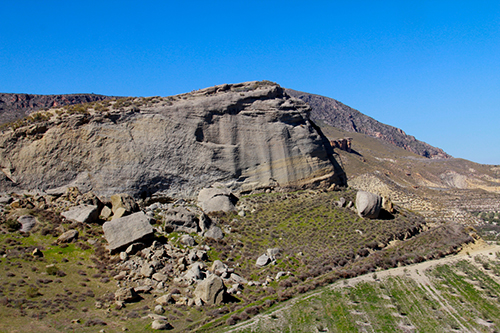 A Gilbert delta deposited on the uplifting flank of the Guadix basin, north of the Sierra Nevada. Notice the decreasing height of the foresets, reflecting infilling and shallowing of the basin.
A Gilbert delta deposited on the uplifting flank of the Guadix basin, north of the Sierra Nevada. Notice the decreasing height of the foresets, reflecting infilling and shallowing of the basin.